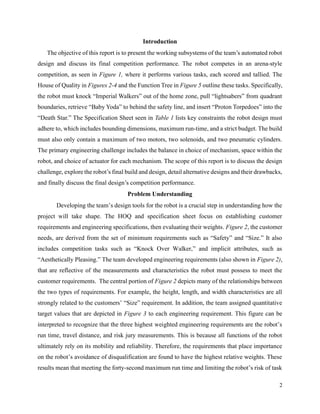This document presents the final design report for a team's automated robot. It summarizes their design process, which included creating a House of Quality to relate customer needs to engineering requirements, a function tree detailing necessary functions, and a morphological chart listing potential solutions. Their chosen design, called Alpha, is a stationary robot that uses drawer slides for locomotion and has subsystems to complete tasks like pulling sabers, grabbing Baby Yoda, knocking over walkers, and inserting protons. The document provides an overview of the subsystems and Arduino algorithm, expected performance metrics, alternative designs considered, and results from competition trials where the robot scored an average of 40 points.




































![36
Works Cited
[1] “Final Design Project: Star Wars.” [Online]. [Accessed 3 March 2023].
[2] “Star Wars Final Design Project: Alternatives Report.” [Online]. [Accessed 3 March 2023].
[3] J. Blevins, “ME2110-A10 Week1 Sp23,” [Online]. [Accessed 3 March 2023].
[4] J. Blevins, “ME2110-A10 Week3 Sp23,” [Online]. [Accessed 3 March 2023].
[5] W. Singhose, “ME2110 Sp 2023 Lect 04 Function Solutions,” [Online]. [Accessed 4
March 2023].
[6] "Catalog," McMaster-Carr, 2023. [Online]. Available: https://www.mcmaster.com/.
[Accessed 4 March 2023].
[7] "Products," Anaheim Automation, 2023. [Online]. Available:
https://www.anaheimautomation.com/. [Accessed 5 March 2023].
[8] "Programmable Industrial Hubs and Switches," Acroname, 2023. [Online]. Available:
https://acroname.com/. [Accessed 5 March 2023].
[9] “Design Tool Guide: House of Quality,” 10 January 2023. [Online]. [Accessed 12
February 2023].](https://image.slidesharecdn.com/finalreport-230702194956-ad3d3ce4/85/ME2110-FinalReport-37-320.jpg)